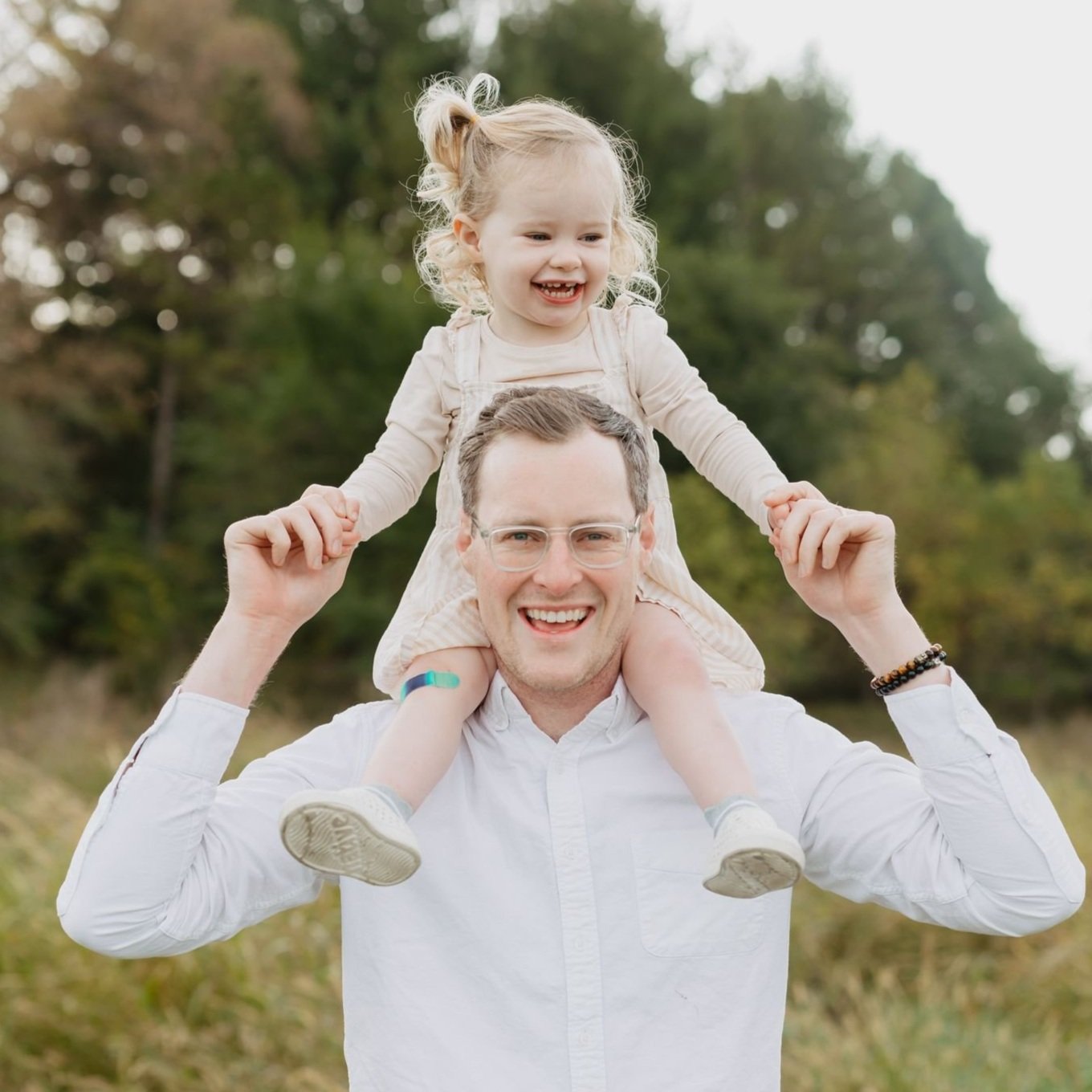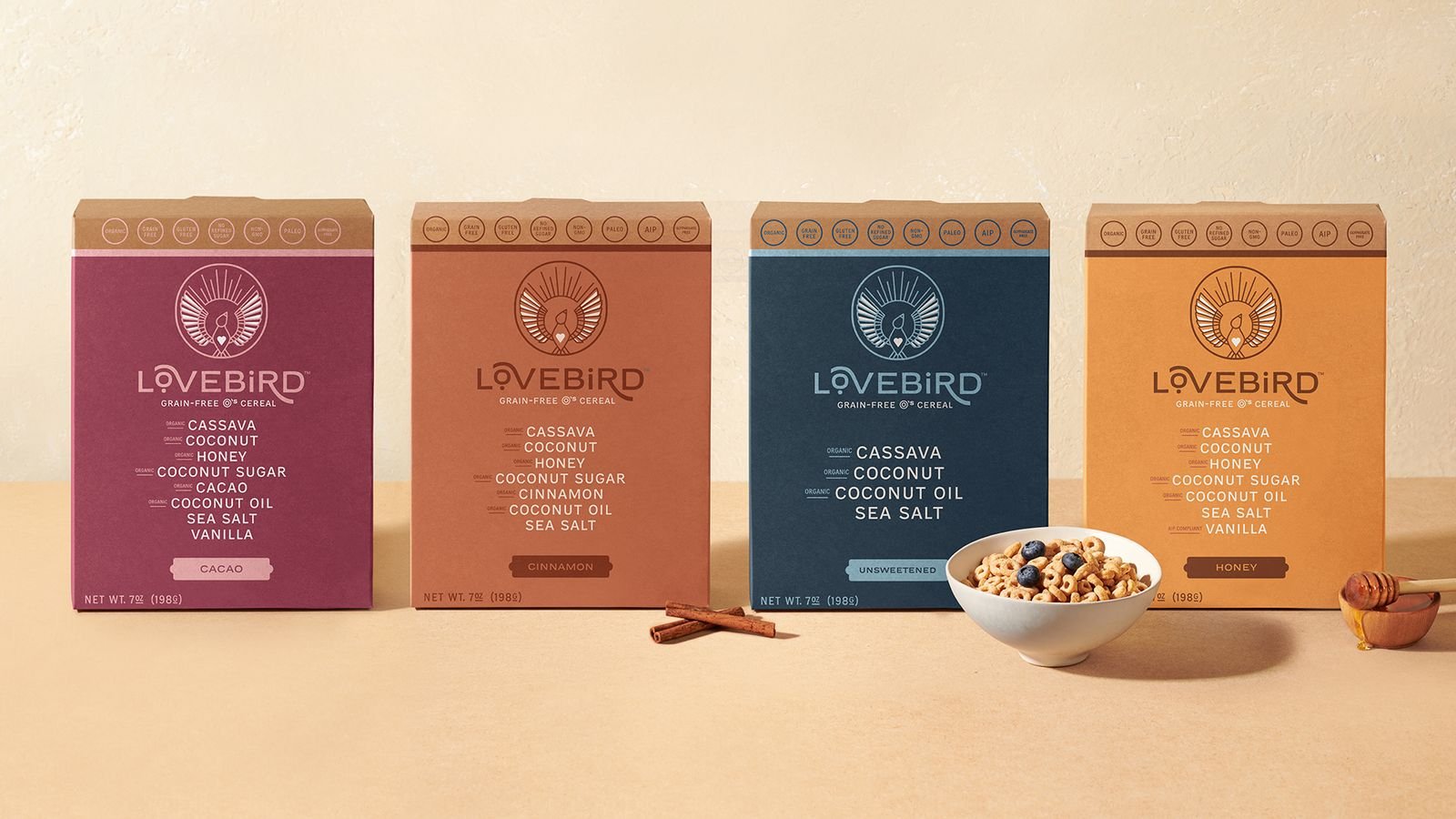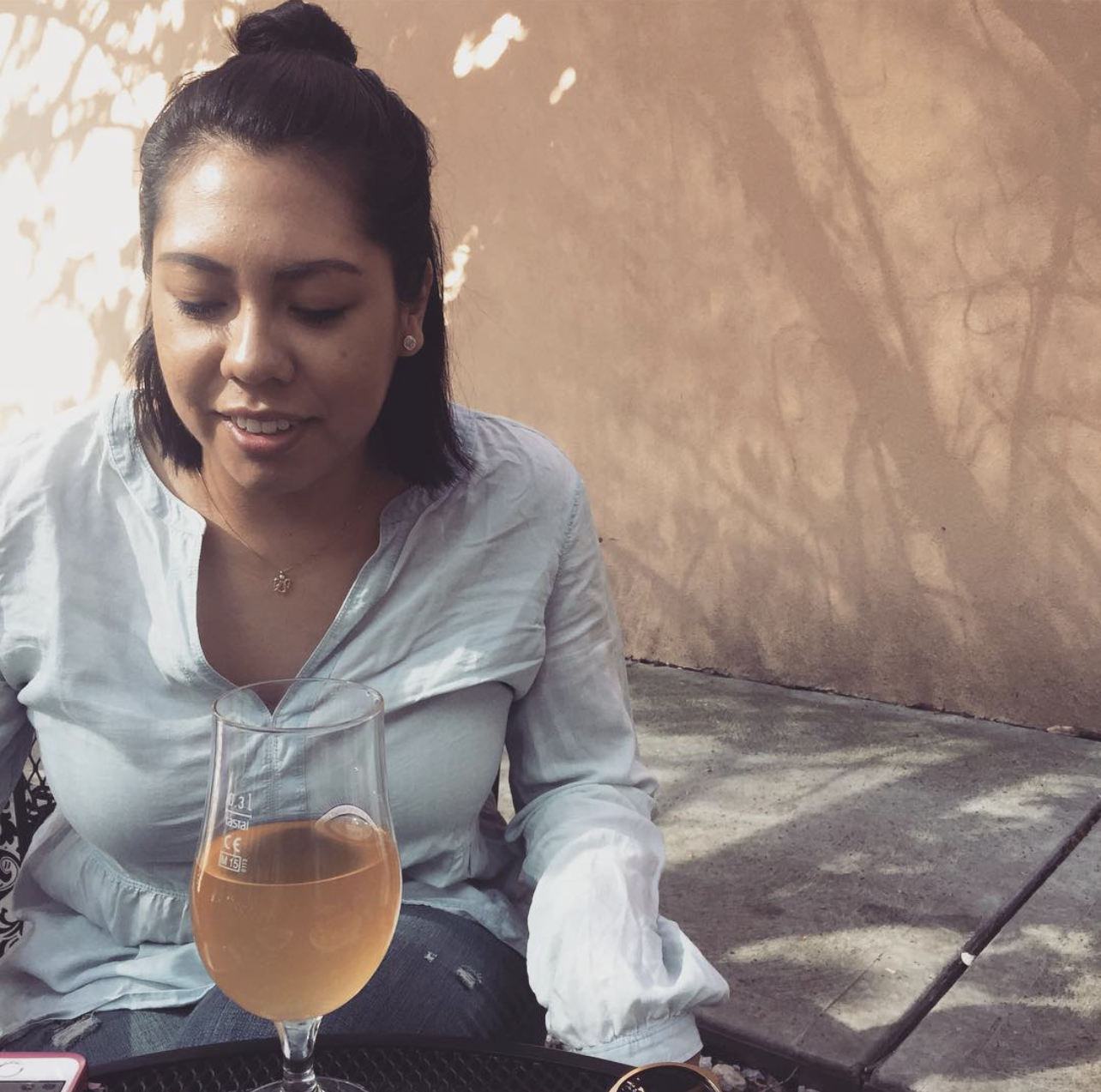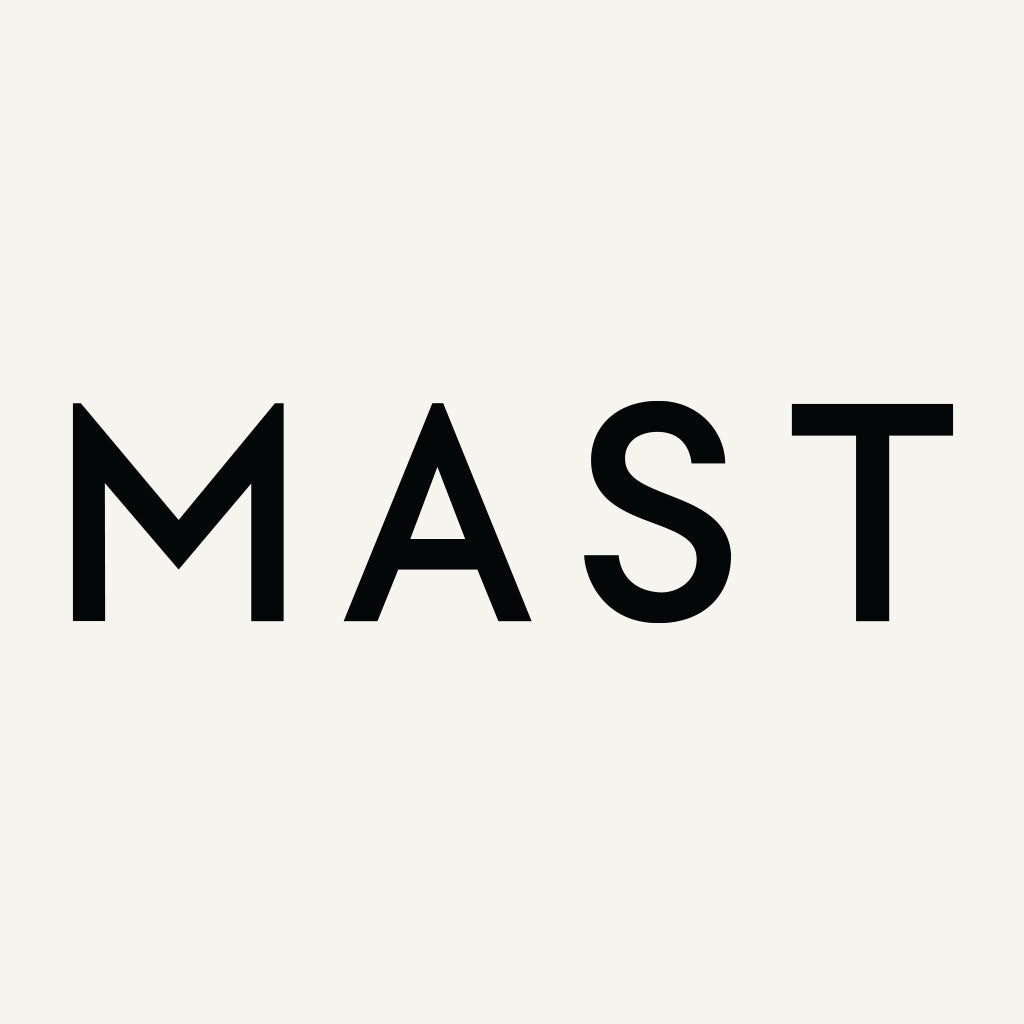Parker Brook is a Cereal Entrepreneur
While working in marketing and branding at General Mills, Parker Brook tried to change the company from within. He had learned the power of food as medicine through his experience managing his autoimmune disease and wanted to help make their products healthier for all types of people. But as his career progressed from Cheerios to Totino’s Pizza Rolls to Nature Valley to Yoplait, he realized he couldn’t achieve the impact he imagined. “I did some cool things there, but ultimately became aware that I would have to leave to make that happen,” he explains.
The birth of Parker’s daughter finally pushed him to quit his General Mills job and launch Lovebird, a cereal company with the dual missions of cleaning up junk food and fighting childhood cancer. “I felt like there was a huge opportunity to make a big difference in a very large category,” he explains. “And cereal is the number one breakfast for kids. But most of it, if not all of it, is not great for you, especially on a daily basis. It's full of refined grain, refined sugars, and seed oils. I took that seriously and made the cleanest cereal on the market.”
Lovebird, which donates 20 percent of its profits to fighting childhood cancer, offers cereals that are organic, grain-free, and free of refined sugars. The unsweetened variety, which is ideal for small children, has just four ingredients—all of which are listed on the front of the box. The cacao flavor has the largest number of ingredients—and there are only eight. “I really just wanted to make something that anybody could eat, no matter what their dietary or allergy restrictions could be,” Parker shares. “The best way to hold myself accountable and communicate to people what it is, was to put every single ingredient on the front of the box.”
Here, Parker shares the special ingredient behind Lovebird’s cereal, how his previous career has shaped the company, and how he stays true to his mission every step of the way.

Mast Market: How did you come up with Lovebird’s cereal recipe?
Parker Brook: There were a lot of messy nights and days in my kitchen, figuring out how to replicate a baked cereal product in my house. Then I took it to some people with actual culinary expertise because I'm not the most culinary-gifted person. And really it turned out that these simple ingredients just work really well together. It's not some sort of complex rocket science experiment where you're trying to balance multiple flavors or to mimic the flavor of honey. It's just like, ‘Yeah, use honey.’
I remember going to some flavor houses—because if you work at a food company, they typically will go to a flavor house that creates, in a laboratory, all these different flavors, from natural to artificial. They will craft that for you for free and then they sell you their flavor. And so when I went to a few of those places, they laughed me out of the room, saying ‘Well, you're not using any flavors. Why would we partner with you? You're just using honey.’
I was like, ‘All right, let's just make real cereal.’ And it's a chip on my shoulder because they told me that it wasn't going to work. Strawberry flavor for kids isn't really real strawberries, it's like Nesquik. And it's all these other things that our palates have been retrained to identify as true strawberry. For me, real food has enough flavor. But nobody wanted to do it because it's more expensive when you're using real ingredients. And they didn't think that there were people out there that cared as much as much about it. So it was an interesting experience, but it ultimately led to a very simple recipe that tastes pretty good.
MJ: But you still do have four flavors. So how did you achieve those four different options?
PB: I just went off flavors I really enjoyed. I also was a new parent, so I wanted an unsweetened, similar to a plain cheerio, to give to my daughter and help her learn how to use her little fingers. It’s also just a nice neutral flavor to use in any recipe or on top of any smoothie bowl or however you choose to use it. And then honey was my favorite flavor, like Honey Nut Cheerios. And then obviously we have cinnamon and cacao, as well. That was just finding the best sources of those different ingredients and making sure they delivered on taste and met my clean ingredient standards. We're also in the process of rolling out a new flavor here in August that I'm excited about.
MJ: That’s awesome. And what is the base of the cereal?
PB: Cassava, which is traditionally a South American root vegetable. Think of it as kind of a potato. But it has more prebiotic fiber than a potato and some other minerals, as well. It’s a pretty good source of vitamin C. It's a sustainable crop and the cassava I source is actually from small farmers in Nicaragua that are being taught to develop their own farms. Like the mantra of, “teach a man to fish, don't give them a fish.” And so it's helping build communities and helping families build businesses that they can run and pass down to their families.
It's also the lowest amount of detectable heavy metals and the cleanest soil in the world that I could find. I've tested every cassava from Vietnam to India, and this cassava from Nicaragua is by far and away the cleanest, especially in this market where a lot of brands will label something as cassava, but it's actually tapioca starch, which is a much more refined version of cassava root, whereas I use just pure cassava. I have flour, which is simply the ground up root.
MJ: That's so interesting. And how did you know that cassava would be the right base for a cereal?
PB: I was looking for prebiotic fiber and something that had healthy carbs and cassava was also very allergen friendly. It's naturally gluten-free and really anybody can eat it as long as they tolerate carbs. And it's a more complex carb, as well, because it's a whole food flour, so your body digests it a bit more slowly and it doesn't spike blood sugar. So it just seemed like a great ingredient to use. I used it a lot in my own grain-free baking as well. And that was where I got the initial idea. It was just an ingredient that had a lot of meaningful health benefits to me.
MJ: That makes a lot of sense. What kind of skills or expertise did you take from your previous career at General Mills to put into this product? And what did you have to unlearn from a bigger corporation?
PB: Great question. I think I had to unlearn more than I learned from it, to be honest. Big food typically operates on ‘How can we get more people to eat more of our stuff without factoring in what should people be eating and how much should people be eating?’ But if I'm going to invite someone over to my house for dinner, I want to make the best possible dinner and use the best ingredients. I don't want to cut the spaghetti in half, I don't want to water down the marinara sauce. I don't want to use lower quality meat or no meat at all. I want to make sure they have the best experience possible.
So I was retraining myself to view people as people and not as “consumers,” which is what a lot of food companies will call people. I always felt like it was a weird word because you're just viewing someone as just literally something that eats your stuff versus a human, an individual with hopes and dreams and aspirations and much broader visions for life. And so it was retraining, not looking at people as numbers and consumers and instead treating them as family and friends.
I did learn a lot about how the food process works and how supply chains work and how to launch a product. And so I definitely had a leg up from just the common person going out there with a really good recipe. That was very helpful. And there's still a lot of great people at General Mills. I still have a ton of friends there and they take really good care of their people. But, for me, it was just really focusing on making the best possible cereal with the best possible ingredients and being true to my mission. And that has made all the difference.

MJ: And where did the name Lovebird come from?
PB: It kind of ties into that previous question around unlearning things. If I still had my big food hat on, I probably would've named it Cassavas or something very generic and not emotional, with very little meaning. But when I left I was like, ‘I'm going to dedicate my life to this and I want it to be meaningful, I want to have purpose, I want to make a difference.’ And part of that was cleaning up junk food and fixing our current broken food system and our industrial agriculture. And then also fighting childhood cancer, which is the number one cause of death by disease for children and historically underfunded, at about 4%.
So I asked myself, ‘What am I going to name this?’ I wanted it to be something equally meaningful to my mission. The name Lovebird was really born out of a few things. One, it was a nickname I had for my daughter when she was first born. She's since just grown out of it a little bit. But when she was first born, it was a nickname I had for her. And I wanted this brand to stand for love, ascension, and protection. And the Lovebird in general represented that, obviously, love is love and birds provide protection in their nest for their young and birds also fly. And so I wanted it to represent those three core tenants.
I was also listening to a lot of “Blackbird” by the Beatles, which has lines like, “Take these broken wings and learn to fly.” And I felt like it really was symbolic of what I was trying to do with cleaning up junk food. I wanted to help people take control of their health and learn more about food and make better food choices and reverse a lot of these staggering trends. Right now, one in two people have a chronic health condition, obesity is like two thirds of America, about a quarter of children are now obese, and a lot of these things are only going to get worse over time. A lot of it comes from the food on the shelf at the grocery store.
MJ: That's very true. Of course, Mast Market carries Lovebird, but where else can people find the product?
PB: I love Mast Market and it has some of my favorite chocolate and I think it's been a mentor brand to me in terms of how you all operate and the standards you keep for your products and just the authenticity that you all have. You can find Lovebird on my website, as well. We're also nationwide at Whole Foods and Sprouts and a bunch of other grocery stores. If you want, you can go to our store locator on our website to find Lovebird near you.
MJ: Perfect. What do you see as the future of Lovebird? Do you plan to stick with cereal or branch out into other foods?
PB: I’m just trying to keep my head above water at the moment. There's a lot going on and it's still a two-person company. I just added a partner to help with the operational side of things and it’s never a dull moment. We're still 100-percent independently owned and I want to keep it that way so we can live true to our mission. So that makes our sandbox a little bit smaller. But there's such a huge opportunity to continue to clean up cereal. And I'm always looking at different categories and where to go next. If anybody has ideas, they can definitely reach out to us on Instagram or email me. I’d be happy to have Lovebird fly to different areas and clean them up.
MJ: That's awesome. How do you incorporate Lovebird into your daily diet and that of your family? Do you eat it dry, as a snack? Do you eat it with milk?
PB: I eat it with milk most of the time. I put it on top of my smoothie bowls for an extra crunch—you can get that crunch of nuts and seeds. It's not as caloric and a little bit cleaner for you to eat, as well. And then there's been a ton of recipes—you can find them on our website—that the community has created, from your crispy bar all the way to pie crust. It’s really cool to see. The possibilities are endless. My children like to eat it and throw it all around the car and make a mess, but they get some of it in their mouth. They love it. We love it. It's nice to have a convenient clean option just to eat and not have to worry about it.
MJ: Does it seem like other people are enjoying it, as well?
PB: To start, I launched Lovebird on my website, just to see if anybody cared as much as I did about the food we eat and where it comes from and how it affects our bodies. And a huge community of clean-eating people rallied around it and it was amazing to see them join in the Lovebird mission. Lately, we've been expanding to retail to continue to grow and reach more people. So it's been a wild journey. And it's been an exercise in finding your purpose, living your purpose, and taking a little bit of a leap of faith to see if there are others out there that believe in the same things you do. And together we're making a big difference.
More from The Journal

Supply In Command with Areli Pino
In conversation with Mast’s Supply Chain Director, Areli Pino.
Read more
Knowing Our Truth on Mother’s Day
Taking a moment to say thank you to the mighty women in my life this Mother’s Day.
Read more